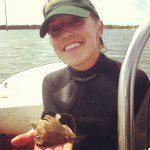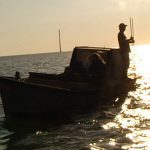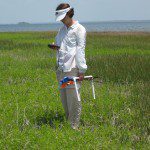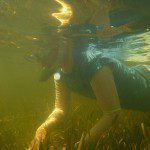An explosion of life occurs where north Florida rivers meet the Gulf of Mexico. The Forgotten Coast is dotted with fishing villages that economically rely from healthy estuary ecosystems fed by these freshwater sources. From 2010 through 2014, our In the Grass, On the Reef project explored the salt marshes, seagrass beds, and oyster reefs that shelter about 90% of commercially fished seafood species at some point in their life cycles.
Oyster Reefs | The Ecology of Fear
Dr. David Kimbro and Dr. Randall Hughes studied the effects of fear on the oyster reef ecosystem. Predators such as stone crabs and blue crabs feed on oyster consumers such as mud crabs and oyster drills. The mere presence of a predator is enough to stop the consumers from eating. Likewise, the presence of oyster consumers can keep oysters from eating, which can stunt the growth of an oyster reef.
How do these cascading fear effects play out on a real life oyster reef? How do these effects combine with other factors to determine the health of the habitat?
The Apalachicola Bay Oyster Fishery
After months of record low flows on the Apalachicola River, one of our countries most productive oyster fisheries collapsed. David Kimbro and his lab investigated the causes of the crash. Low river flows cause saltier water in the bay, causing an increase in the breeding of oyster predators such as oyster drills and crown conchs. Was this predator explosion the sole cause of the fishery problems, or did they combine with other factors.
We recently revisited the Apalachicola Bay estuary for a look at its slow road to recovery.
Salt Marsh | Biodiversity In the Grass
While we don’t eat marsh grass, the ecosystem is equally important to commercial fisheries as oyster reefs. Dr. Randall Hughes researched the effect of biodiversity on the health of this habitat.
A single genetic individual of the dominant marsh plant, smooth cordgrass (Spartina alternifora), can cover a lot of ground in the marsh. But is the habitat more successful with a higher diversity of individuals? Additionally, how does the diversity of plant and animal species benefit the marsh?
Seagrass Beds
Dr. Kimbro extended his research into predator fear to the seagrass beds of Bay Mouth Bar. This small sand bar off of Alligator Point is exposed during monthly full moon low tides, revealing a great diversity of predatory snails. Here, legendary ecologist Dr. Robert Paine started to form his ideas on keystone species, observing changes in predator/ prey dynamics when the top predator, the horse conch, left the reef in the winter. Since the 1950s, the true tulip, another top predator, has disappeared from this system. David’s graduate student, Tanya Rogers, examines the effect this might have had on predators, prey, and even the seagrass itself.
In the clear waters of St. Joseph Bay, D. Hughes and visiting professor Dr. Peter MacReadie tell us about the incredible ability for seagrasses to store carbon.





